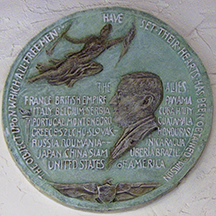A century ago, on the 11th day of the 11th month, the Great War officially ended. It was naively called “the war to end all wars” and succeeded in that lofty goal for less than two decades. Millions died in combat, and an equal number from the influenza pandemic it enabled. Combined military and civilian casualties are estimated at 40 million. It propelled the world into fits of industrial, scientific, and artistic creativity, but it also introduced the term “weapon of mass destruction.” People of the European countries where the ugly conflict raged regularly remember the dates, honor the fallen, and memorialize the sites.

In 1926 — eight years after the war’s end — wealthy East Coast dilettante Alden Freeman remade Santa Barbara’s Franceschi House into a memorial of his own design. He covered the original redwood clapboard with stucco in ostensible homage to Franceschi’s Mediterranean heritage, but it is also conveniently in tune with the then-modern Spanish Colonial Revival style encouraged by Pearl Chase through her Plans and Planting Committee during Santa Barbara’s 1925 earthquake rebuilding. Mounted in the stucco were more than 80 large medallions, each a memorial to a person, event, or place Freeman admired. Two medallions were dedicated to the Great War.

Visitors today will easily see on one the profile of President Woodrow Wilson and the inscription, “The object upon which all free men have set their hearts has been obtained.” The list of allies includes countries both unexpected — Guatamala (sic), Honduras, Nicaragua, Liberia — and archaic — Serbia, Siam, Szecho-Slovak, Montenegro. The companion medallion honors “The Great Generals of the Allied Armies in the World War • Victory 1918,” including busts of King Albert, Diaz, Generalissimo Foch, Haig, Pershing, and Petain. The names are largely forgotten in America today.
Five years after donating the remodeled Franceschi House and grounds to the city, Freeman built his own home in Miami Beach with similar medallions. He named it Casa Casuarina, but it is better known today as the Versace Mansion. Due to the protection of interior courtyard placement and minor upkeep, those medallions have survived the decades better than ours and were refreshed in the 1980s when Versace acquired the property. Visitors today can stay at The Villa Casa Casuarina ($615, breakfast included) to view them or see them on the house in Franceschi Park for free.

 on Google
on Google 

